1 Computer Simulation and Gaming
1.1 Calculators
After almost a year of literature survey, I decided to investigate the effect of the heat of chemical reaction to the rate of diffusion, for my Ph.D. thesis research at the Chemical Engineering Department [1] of Polytechnic University (formerly Polytechnic Institute of Brooklyn) in Brooklyn, New York. It was around 1960. Such chemical reaction was a common phenomena, e.g., absorption of sulfuric or nitric acid gas into water, etc., which later became one of major concerns for the prevention of air pollution.
Basing on the McCabe-Theile's two-film theory [2], I constructed a mathematical model of several highly non-linear simultaneous ordinary differential equations with two split boundary conditions for the chemical reaction [3]. I took a course on numerical calculations, and started to solve the set of equations with a hand-cranking "Tiger" calculator (see footnote [4] about an incident which led me to create the logo of our GLOSAS/USA) [5]. My arm soon got tired. I then found an electro-mechanical (not electronic) [6] "Monroe" calculator in a professor's room, and begged him to let me use it. It still took me many hours and days to come up a single case study of such a set of highly non-linear simultaneous differential equations.
A friend of mine then suggested that I should take a programming course for a new electronic computer IBM 650. It was with a tedious machine language, and I easily got lost with it. I said to myself "Down with IBM!!" and quitted the course after a few days of attendance. I was completely lost and frustrated, couldn't find what to do for many weeks and was deeply depressed. However, I had to solve the mathematical model to finish up my Ph.D. study.
1.3 Slow-time analog computer
One day, I was wondering around the floor of Electrical Engineering Department and found a strange machine. It was a slow-time analog computer with about 200 to 300 amplifiers [7]. It was 6 to 8 foot high, about 20 to 30 foot long, and 2 to 3 foot thick -- there were two banks of them, each having one servo multiplier immersed in an oil bath. The programming board was just like a telephone switching board with long codes which were to be inserted in large holes on the programming board. When a code was released from a hole, it snatched back into its place on a table.
I started using it with amazement. After programming my model, it became a spaghetti board as running the codes from corners to corners. I could see a multiplier disk floating in an oil bath slowly moving to finish a multiplication. To change a numerical parameter, I had to turn a large potentiometer on the desk. The computational outputs were plotted on a large (almost a foot by a foot) plotter which was often used for industrial process control in chemical plants. It was very slow and insensitive to parameter changes. I had to watch patiently the outcome on the plotter if a new parameter setting could shoot its target value at the end of computation. Since my goal was to come up a chart of coefficients of chemical reaction with the level of its activation energy, I had to spend many nights to repeat similar computations, but I still could not see when I could finish my research study [8].
1.4 Repetitive analog computer
One of the professors then kindly introduced me a part time job for the operation of a newly acquired "repetitive" analog computer (manufactured by Electronic Associates, Inc. (EAI) in New Jersey) at Shell Oil Headquarters in Rockefeller Plaza Building in Manhattan. I assisted their jobs of simulating chemical reactions, process control, business operation, etc. in day time, and worked on my thesis in night time -- often till mid-night -- with free of charge for the computer usage [9]. This analog computer gave me substantial speed increase. I could watch the computational results on an oscilloscope if a parameter setting could shoot a desired target, and if did, I could read its digital number out of analog/digital converter [10]. Though I had to record the number manually, this repetitive operation could save my time tremendously for trial and error calculations. However, its 500 or so amplifiers were quickly used up for my simulation model so that I had to hang up many extra capacitors and resisters on the programming board to supplement amplifiers [11].
1.5 Continuous system simulation languages
Soon after I moved to Mobil Oil Headquarters in Manhattan in 1964, I encountered with a continuous system simulation language program, Modified Integrator Analog Digital Simulator (MIDAS) made by Martin Marrietta Corporation in Florida. It used a digital computer (e.g., IBM 704 with vacuum tubes, 7040 with transistors, etc.). Its programming language was, however, very tedious, just like for analog computer programming diagram with adders, integrators, multipliers and potentiometers, etc. The diagrams with their pictorial icons and connecting lines often overflowed even on large sheets for complex modeling. Each of those mathematical operations had to be punched on a separate card. It did not have any graphic print-out feature so that a friend of mine (George Armstrong) brought me a subroutine program which could plot the computational results with ASCII characters on x-y axes by high speed line-printer, which graphic was similar to the one I could plot with the slow-time analog computer at the Polytechnic University [12]. A few months later, Martin Marrietta upgraded MIDAS with MIMIC to circumvent the difficulty of analog computer type programming, i.e., MIMIC was equation-oriented digital simulation programming system so that we could just copy differential equations with its programming language without separating each mathematical operation.
Probably because one of external board directors of Mobil Oil was James Watson, then Chairman of IBM Corporation, Mobil was a beta testing site for IBM at that time. One day, an IBM salesman brought me a deck of punched card and a user manual of Digital Simulation Language for IBM 7090 (DSL/90), another continuous system simulation language program. The user manual was stamped as their internal secret program [13]. This and its successor, Continuous System Simulation Language 360 (CSSL/360) was much easier than MIDAS or hybrid computer, though the computer speed was much, much slower than analog or hybrid. Although there was a merit with MIMIC, I chose to use DSL/90 for my simulation work, and often called its originator (a Chinese from Singapore) at IBM/San Jose, California office whenever I encountered with any error messages [14].
1.6 Global time-sharing services
As being the beta site of IBM, there was also an IBM 1401 with a large magnetic storage drum which was hooked with telex system, a forerunner of in-company global time-sharing system. One evening when I was using it for my statistical analysis, its response got suddenly slow down. A friend of mine exclaimed "Aha, Australians must have started using it!" since it was about when their office time began in Sidney [15].
1.7 Hybrid computer
At the central research lab of Mobil Oil in New Jersey, I had an occasion of simulating chemical reactions in the shale oil retort in Colorado. This was to extract oil out of rocks from Rocky mountains, which reservoir was said more than that in Middle Eastern countries. It was around 1965 to 1966 when major oil companies were getting afraid of oil crunch which came in early 1970s. Crashed shale oil rocks were fed from the top of the retort. Hot heat from burning oil was fed from the bottom of the retort tube, and heated air was fed from the middle of the tube. The simulation model was consisted of several highly non-linear simultaneous partial differential equations in four dimensions (xyz-axes of space and time) with three split boundary conditions at the top, the middle and the bottom of the retort. I could use a newly constructed Beckman Instruments' hybrid computer in Richmond, California, for almost exclusively about a half year -- continuously day and night. The computer had two banks of analog computers (with 500 amplifiers on each) which were hooked to Xerox's Sigma real-time digital computer [16].
I then had to convert this model with DSL/90 (and later DSL/94), as running it on IBM 7094 at Mobil Oil Headquarters many nights [17]. It was around 1966 to 1967. Even though I used the 6th-order predictor/corrector numerical integration method, some graphical outputs from a line-printer often had very severe fluctuations on concentration curves which were out of sense. I later learned that it was caused by the truncation error, and a scientist at M.I.T. dubbed it as a "Butterfly Theory" [18].
1.8 Dumb terminal with monitor
While I took some courses at Sloan School of Management of M.I.T., I worked at Stone and Webster Engineering Company in Boston on the design of ethylene plant, the most basic of petrochemical industry, with computer simulation of chemical reactions in naphtha cracking furnace and of process control of the entire ethylene plant which total cost ranged from $800 million to $1 billion dollars. Since the plastic industry with synthetic organic chemistry was just getting to bloom, and since Stone and Webster was one of a few major design companies, demand for building such ethylene plants from around the world was enormous.
By that time, IBM produced Model 360, and their Continuous System Modeling Program (CSMP) with MIDAS type programming was converted to the one with the DSL/90 type equation-oriented simulation language, and dubbed as CSMP/360. I had a dumb terminal in my office which was hooked to IBM 360 time-sharing machine in Danver, Connecticut, one of the first time-sharing service offering vendors -- via a leased line. Instead of submitting our job with many boxes of punched cards to an IBM/360 in a computer room, I could operate the time sharing machine from my office with similar graphical output as the one from a line-printer. We then attached a storage type oscilloscope made by Tektronix and could view the computational output on it -- it was in late 1960s and the forerunner to the similar computer screen outputting with a desktop personal computer nowadays.
1.9 All-in-one approach
In parallel to the above activity, I also developed a combination of CSMP/360 simulation model for a petrochemical process control dynamics with a large material balance program, a statistical analysis program (BMD) and various hill-climbing optimization programs (including linear-programming). We dubbed it as Stone & Webster All Purpose Simulator and Optimizer (SWAPSO) <Utsumi, T., C. H. Jones and L. Chin, 1970>. While CSMP simulated the dynamics of ethylene plant process control, the material balance program checked the input output balance of individual units with statistical analysis at a specified time interval. Each of three component programs were huge at that time. This was the so-called "All-in-One" approach nowadays [19].
1.10 Summer Computer Simulation Conference
I presented our papers on those activities at the Conference on Applications of Continuous System Simulation Language in San Francisco, California in 1969 which was organized by Bob Brennan of IBM. After listening those papers, he requested me to organize the following year's conference as Program Chairman. I duly accepted his request with the condition of changing its long name to Summer Computer Simulation Conference (SCSC), since there was a similar conference in competition for discrete simulation group, which was usually held in winter time. General Chairman of the 1970 SCSC was David Miller of Denelcore in Denver, Colorado, which company produced analog and hybrid computers for the U.S. defense and NASA facilities. Since the computer simulation was becoming wide-spread, ubiquitous tool in research and development and engineering fields of every disciplines, I designed the conference with multidisciplinary approach (Utsumi, T., 1970, "A Message from the Program Chairman"). It was a tremendous success and the first of its kind. The most memorable presentation was the computer simulation of global climatology by Dr. Kasahara of the National Center for Atmospheric Research (NCAR) in Boulder, Colorado, with the use of Cray's supercomputer. His presentation let me understand that the computer simulation of such a global system was possible with rational and critical thinking and analysis. This notion led me to have a session on macrosystem simulation during the following 1971 SCSC.
1.11 War and peace gamings
Thanks to the success of this SCSC in Denver in 1970, I was then appointed to conduct the 1971 SCSC in Boston as General Chairman [20]. It gathered more than 600 attendees, the largest ever for SCSC (Utsumi, T., 1971a, "A Message from the General Chairman" [21]). We could peek the future of virtual reality with 3D graphics of an airplane circulating over an air field to land on its runway. A session on macrosystem simulation was moderated by John McLeod, and a team member of the "Limit to Growth" project at M.I.T. presented an overview of their activity prior to its publication a half year later. A professor from the U.S. Naval Post Graduate School in Monterey, California presented his work on war gaming. His last words were "War gaming cannot be perfect without having its models tied together with simulation models of civilian sectors" (Utsumi, T., 1971b, "Peace and War Gaming") As recalling industrial, urban and world dynamics studied at M.I.T., I said to myself "Well, we may be able to help them as doing, at least, the simulation of the civilian part" (Utsumi, T., 1971c, "Comparison between War and Peace Games" [22]). This culminated in my motivation for creating Globally Collaborative Environmental Peace Gaming [23] and Global (electronic) University System to supply its game players -- more later.
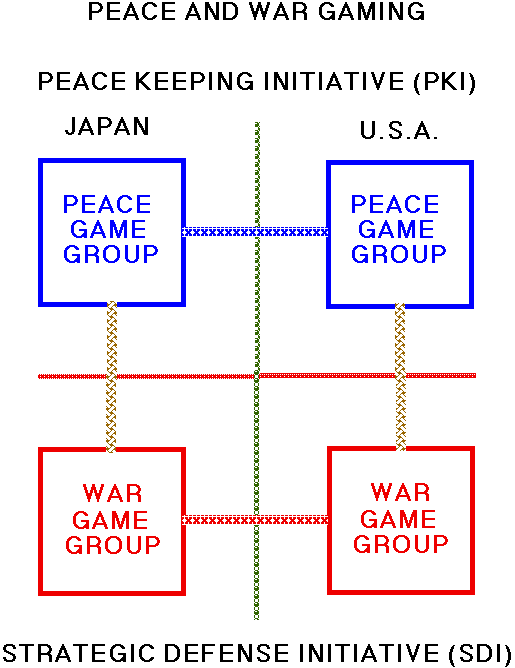
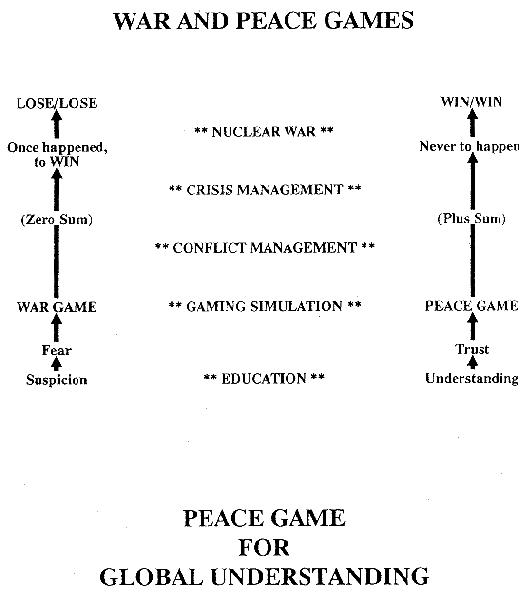
1.12 E-mail through global time-sharing service network
After moving to Mitsubishi Research Institute (MRI) in Tokyo in 1972 [24], I devoted myself for the promotion of the use of computer simulation and systems dynamics with time sharing of IBM/360 (which was only one of the two in Japan at that time). I also had to come to the U.S. to attend many conferences. This frustrated me greatly, not only with its hectic schedules, but also by the fact that I could not keep contacts with valuable friends whom I had fruitful conversations at those conferences, due to slow airmail and high cost of overseas telephone calls and telex messages from Tokyo. On the other hand, GE's time-sharing service (GEISCO, the predecessor of GENIE) was extended to Tokyo out of Cleveland, Ohio around that time. I immediately subscribed to it [25]. Whenever I found its users during my trip in the U.S., I borrowed their terminals of GENIE and could contact my secretary in Tokyo by e-mail. However, its users were a few among my American colleagues, and its e-mail service was only for its users in the same organization, but not with any persons of other organizations.
1.13 Idea of globally distributed computer simulation system
On the other hand, the "Limit to Growth" (which was the outgrowth of the World Dynamics by Jay Forrester of M.I.T.) was published by Readers' Digest in the spring of 1972, and severe criticisms started appearing in many journals and newspapers [26]. The main point of the contentions was on the credibility of the data they used, i.e., how a group of only a few scientists could claim that they knew everything of the world. My thought to the criticisms was then why not do we take Greyhound Bus Company's motto "Leave the driving to us," i.e., distributing computer simulation submodels representing functions and responsibilities of individual sectors and countries, to appropriate locations where they should have belonged and connecting them via telecommunications. Credible data and model structure could have been brought by the experts of those sectors and countries to which no one could complain or blame.
2 Packet-switching data communication network
In the summer of 1972 in Tokyo, I had an occasion to meet Carl Hammer, Director of Computer Science of UNIVAC in Washington, D.C. [27]. He invited me with funds from the U.S. National Science Foundation to present a paper about our GLOSAS project at the first International Conference on Computer Communications (ICCC) held in Washington Hilton Hotel in October, 1972 -- that was my first public presentation of the project.
At this conference, I saw two technological advancements; one was the demonstration of ARPANET, though it was still primitive with 64 or so participating universities around the U.S. [28], and the other was EMISARI computer-mediated conferencing (CMC) system which later became the Electronic Information Exchange System (EIES) of New Jersey Institute of Technology -- more later.
The ARPANET (Maps of ARPANET) was a narrow-band (64 Kbps) data communication network which was based on packet-switching technology invented by Paul Baran at Rand Corporation in Santa Monica, California in 1962 (Malik, R., September 8, 1977). John Postel of the University of Southern California constructed the so-called TCP/IP protocol. Paul Baran and John Postel were true founding fathers of the packet-switching data communication networks which eventually evolved into one of the major technological innovations of our time, the Internet.
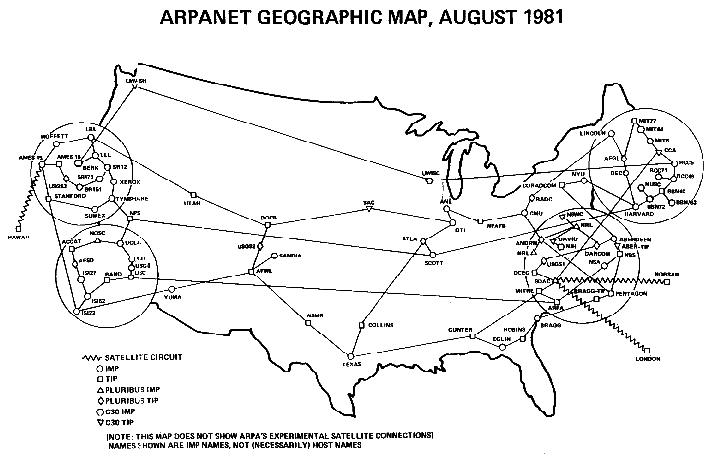
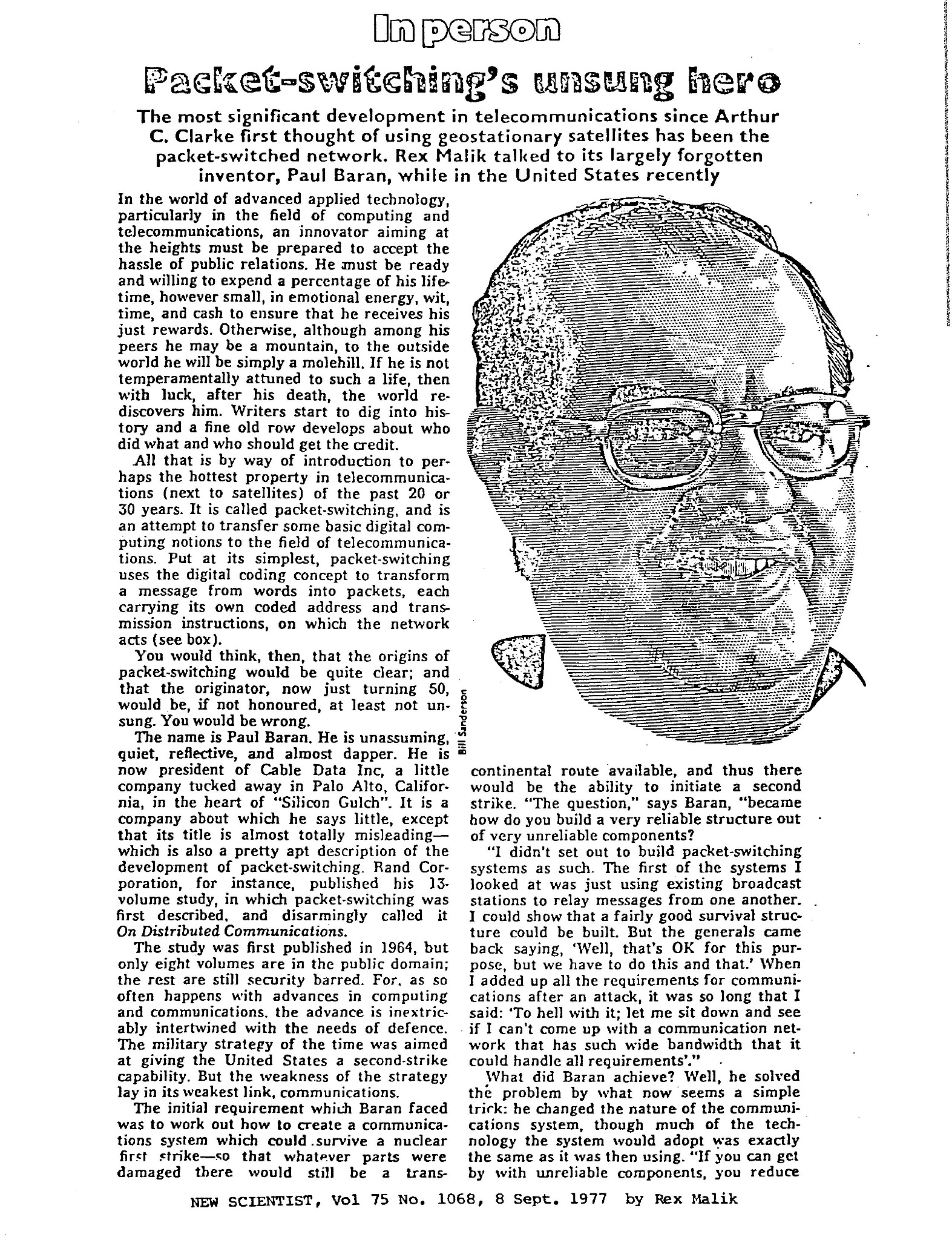
2.1 Failed effort to extend ARPANET to Japan
I thought this ARPANET could be utilized for global peace gaming, and started working on to extend it to Japan. This was also because I heard that it had already been extended to the U.K. (actually via Western Union International's satellite link to Norway and from Norway to the U.K. via undersea cable) [29]. I visited ARPA and BBN many times [30], and also tried to persuade Bob Kahn (successor to Larry Roberts for the ARPANET) when he visited Tokyo. My efforts were in vain everywhere I visited. I later learned that the reason why it was extended to Norway was to detect the seismic wave of the underground nuclear testing in Soviet Union [31]. I also later learned that the reason why nobody was interested in extending it to Japan was due to the fact that Japan was an island and thus was not suitable to effectively detect the seismic wave of the underground explosion from Soviet Union -- I later found that there was a node of the ARPANET in Seoul, Korea, to which Japanese governmental research labs were connected via terrestrial line, and then to access ARPANET via satellite from Seoul. Japanese universities were also anti-militarism so that none of them were interested to do anything with the U.S. Defense Department.
2.2 Inception of global peace gaming
After attending the 1972 SCSC in San Diego, California, I visited Bob Noel of the Political Science Department of the University of California at Santa Barbara. A conference room had a wall-size world map with an American flag standing by. It was as if a situation room of a governmental agency. The adjacent room was a control room with a short-wave radio which could receive world news instantaneously. The room's wall adjacent to the conference room had a glass window from which they could video tape the activities of the conference. Dr. Noel was conducting a political gaming simulation on international affairs using ARPANET [32], by assigning several different schools to act as the governments of the United States, Soviet Union, Japan, China, etc. Students had to study about the assigned countries before the start of the game.
I asked him who was acting for Japan. He said the University of Southern California. So I said to him, "However hard Americans may study about Japan, they cannot think as Japanese, since they eat stake with a knife and fork while Japanese eat noodles with chopsticks." So I proposed that he invite the University of Tokyo to play the role of the Japanese government. During my conversation with Bob Noel I also proposed him that all participating game players should have their systems dynamics type computer simulation model test and predict their proposed policies so that they could make quantitative discussions basing on reliable facts and figures [33].
Jay Forrester of M.I.T. once said that the primary purpose of systems dynamics simulation is NOT for its prediction/forecasting, but for the clearer understanding of such interdependent relationship of social factors. I thought that this, with scientific and rational analysis and critical thinking, ought to be the basic principle of global education for peace (Millennium Institute) [34].
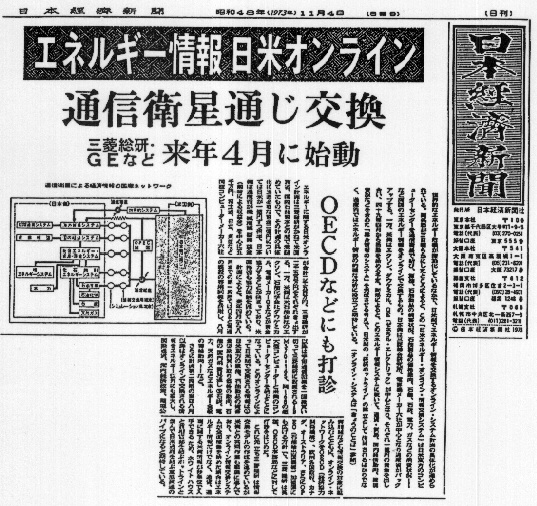 This was when the original idea of Globally Collaborative Peace Gaming was born -- more later -- (Nikkei Shimbun, November 4, 1973), -- and my inquiries to Bob Noel were based on the words John McLeod once mentioned that the first step of simulation was to make simulation exercise as close to the simuland (i.e., the target to simulate) as possible [35], since simulation projects often consume huge resources.
This was when the original idea of Globally Collaborative Peace Gaming was born -- more later -- (Nikkei Shimbun, November 4, 1973), -- and my inquiries to Bob Noel were based on the words John McLeod once mentioned that the first step of simulation was to make simulation exercise as close to the simuland (i.e., the target to simulate) as possible [35], since simulation projects often consume huge resources.
In the spring of 1973, I conducted the world-first global "Peace Gaming" with Bob Noel with the use of e-mail over computer networks. I invited the University of Tokyo and he invited the University of Brussels and the University of London in addition to several universities in the U.S. It was a "normative" gaming as exchanging diplomatic e-mail messages without the use of quantitative computer simulation models. American universities sent their messages through ARPANET and overseas universities through GEISCO. Students acted as if the heads of states and cabinet members of assigned countries. All messages were accumulated and re-distributed by a node at the University of California in Santa Barbara. The scenario designed by Bob Noel assumed an international crisis with a border incident between Iran and Iraq -- which actually happened about 10 years later <Utsumi, T. and A. Garzon, 1991 >. Japan team sent their messages to the United Nations team asking to make the Straights of Maracca an international zone to secure oil flow from the Middle East to Japan, asked the U.S. and Soviet Union teams to withdraw their navy fleets from the Pacific and Indian Oceans respectively [36] [36a].
2.3 E-mail as message exchange via computer
A few weeks later, a salesman of GEISCO came to my office and asked to terminate this exciting global gaming upon instruction of KDD. Another few weeks later, however, the same salesman of GEISCO handed me an e-mail message from a Norwegian in Oslo (who was one of the team members of the "Limit to Growth" project at M.I.T.). The e-mail asked me the name and address of the person who installed DYNAMO simulation language in the GEISCO time-sharing service mainframe computer in Cleveland, Ohio [37]. Upon my insistence, the salesman explained that our gaming simulation had to be stopped due to the Japanese telecommunications regulations, which strictly prohibited the message exchange through a computer without changing its contents -- more later, -- though such message exchange was performed by the node at Bob Noel's office in Santa Barbara, California, which was clearly outside of the Japanese judicial domain [38]. On the other hand, his e-mail from Norway was permissible because it was transmitted by a salesman of GEISCO in Oslo to him in Tokyo -- both were in the same organization. I thought that this was patently unfair, and this triggered my deregulation efforts on the use of e-mail [39] -- more later.
2.4 U.S.-Japan Energy, Resources and Environment (ERE) peace gaming
In 1974, NSF indicated a grant (about $150,000) possibility to our American counterparts (Oregon State University and Bettelle Northwest Lab) and the Japanese Ministry of International Trade and Industry (MITI) a grant (about $320,000) to the Japan Team of GLOSAS/JAPAN Association at Mitsubishi Research Institute for our conducting a U.S.-Japan Energy, Resources and Environment (ERE) peace gaming with a joint simulation model in a host computer of GEISCO in Cleveland, OH <Utsumi, T. and E. A. Eschbach, 1974>. Since I could not stay with Mitsubishi, this project was not materialized [40].
2.5 Wireless data telecommunications
In 1973, I created GLOSAS/JAPAN (Dr. Schun-ichi Uchida, former president of Tokyo Institute of Technology as its Chairman, Mr. Jiro Yoshikuni, former vice minister of finance as its Vice Chairman, and I as its Technical Director).
One day, I visited the headquarter of Chichibu Cement Company in Tokyo and witnessed their videophone via microwave between the headquarter and their plant which was located about 150 miles north of Tokyo. The plant was in a remote area surrounded by the mountains. It took almost 6 hours by train for their staffs to visit it from Tokyo office. Albeit very expensive set up, this saved considerable time and money for their business.
On this visit, I found a transceiver on their roof top which was about to be discarded. I asked them why. They replied that its frequency had to be moved to other location, since the administration of Advanced Technology Satellite-I (ATS-I) of NASA was about to be transferred to the research laboratory of Nippon Telegraph and Telecommunications (NTT) due to its wobbling by the depletion of its fuel and hence drifted to the west of the Pacific area. The frequency of ATS-I was the same as the one Chichibu was using.
I then arranged for their donation of the transceiver to the University of Electro Communications in Tokyo, since they were about to start their link with the Aloha project at the University of Hawaii. They sent their instructional data to Hawaii via telex, and received the computer output via ATS-I with the use of large Yagi antenna.
I later visited Norman Abramson, who originated Aloha project as adapting the packet switching technology for wireless data communications -- he was the inventer of wireless Internet. He showed me his experimental setup which was regularly receiving weather data from the top of Diamond Head of Oahu Island to his office through clear line-of-sight. He later agreed to be one of the advisors of my profit-oriented Global Information Services, Inc. which was established in 1977 in New York.
Late Professor Juro Oizumi of Tohoku University (a renown wireless telecommunications expert) was helping the people at the University of Electro-Communications. He was surprised to learn that Norman Abramson was experimenting the transmission of data embedded into a voice communication channel -- which is a norm nowadays (like computer-mediated multimedia system, e.g., ShareVision -- more later). He told me that the Japanese government which controlled monopolistic telecommunication industries would never allow it even as an experiment, since their mind was totally dominated with the concept of circuit-switching technology -- more later.
Around that time also, Oizumi's group was also testing a very interesting way of data telecommunications. They mounted a transceiver and antenna on an automobile and investigated reflection of microwave by buildings and city noises in Tokyo, albeit very slow speed at that time [41].
3 Extension of U.S. packet-switching data telecommunication to Japan
3.1 Inauguration of commercial packet-switching service in the U.S.
Telenet (which became GTE/Telenet and now Sprint) was established in 1976 by BBN with Larry Roberts (former BBN man and then Director of ARPANET) as its president, in order to commercially provide packet-switching data telecommunication services -- the so-called unregulated "enhanced services" or value added network (VAN). I immediately visited them in Washington, D.C. and started helping their overseas expansion and use of e-mail (then, Telemail, and later SprintMail). They confronted with a decision on either their overseas extension should be conducted by themselves or to rely on the already existing telex service providers, e.g., ITT World Communications, Western Union International (WUI) or RCA Global Communications (Globcom). I commended them to take the latter [42].
3.2 Effort of extending U.S. VANs to overseas
Because of anticipated resistance by the Japanese telecommunication industries (e.g., the Ministry of Posts and Telecommunications (MPT), KDD and NTT), I promoted the awareness of Japanese on the new packet-switching technology with many publications in professional journals which resulted articles in major newspapers appealing to retrieve "treasures" of abundant information from the U.S. [43] (Nikkei Shimbun, November 27, 1978) (Asahi Shimbun, March 12, 1979) (Nikkei Sangyo Shimbun, March 22, 1979). I also helped American telex service providers to extend Telenet's service through their networks to Philippines, Hong Kong, Singapore, Australia, New Zealand, Taiwan, etc. [44].
During this process, I visited the governor of Guam Island, since Guam is the hub of underseas telecommunications cables around the Pacific rim countries. I also visited British Telecom and Cable & Wireless (C&W) in London, since C&W controlled the telecommunications of Hong Kong. I thought that if Hong Kong would get Telenet, KDD would have to follow the suit since C&W in Hong Kong was a keen rival to KDD. In February of 1978, I attended the First Transnational Data Regulation Conference organized by European Parliament and held in Brussels, Belgium. I appealed the delegates from European telecommunication industries and governments for globalization of VANs. However, I was shocked to find the articles in a major British computer industry journal to oppose my appeal (Computing Europe, February 16, 1978), especially in such a country as Britain where global governance of colonial commonwealth was once prominent -- another example of how difficult it is to change "mind" for new technology.
After Taiwan got the extension of Telenet, KDD finally decided to have it also. In response to the KDD's decision, American telex service providers submitted the U.S. Federal Communications Commission (FCC) their applications to extend their services to Japan.
3.3 Battle to inaugurate KDD's ICAS data telecommunication service
The American telex service providers' applications met with counter-petitions from GEISCO and CDC to block their extensions to Japan until Japan de-regulated their telecommunications policies. This was because GEISCO had serious difficulty to extend their services to Japan compared with the case when they extended their services to Hong Kong with Cable and Wireless of London. CDC's contention was this (Norris, William C., "Limiting Japan's Access to Our Research," The New York Times, July 24, 1983); Previously, IBM sold their time-sharing service in Cleveland, Ohio, to CDC due to their consent with the Justice Department, which service was then extended to Japan. CDC tried to provide their Cyber service in Minneapolis, Minnesota to Japan, also. Instead of having a direct leased line from Minneapolis to Tokyo, they wanted to connect their mainframe computer in Minneapolis with the time-sharing service computer in Cleveland, and use its leased line from Cleveland to Tokyo. This meant that the computer in Cleveland had to route data from Minneapolis without changing its content. This was an infringement of the Japanese telecommunication policy, though such routing was to be done outside the jurisdiction of Japan. I submitted a thick petition with many letters of support to the FCC for countering with GEISCO and CDC, with contention that Japanese were not totally ignorant, and if it was allowed, they would realize by themselves how their regulations were so ridiculous [44a]. A famous law firm in Washington, D.C. said on behalf of CDC (billions dollar revenue firm) that my favor to the American telex service providers was "patently unfair." The FCC finally announced their decision saying that they duly considered my contention for their decision [45] (Nikkei Shimbun, December 15, 1979).
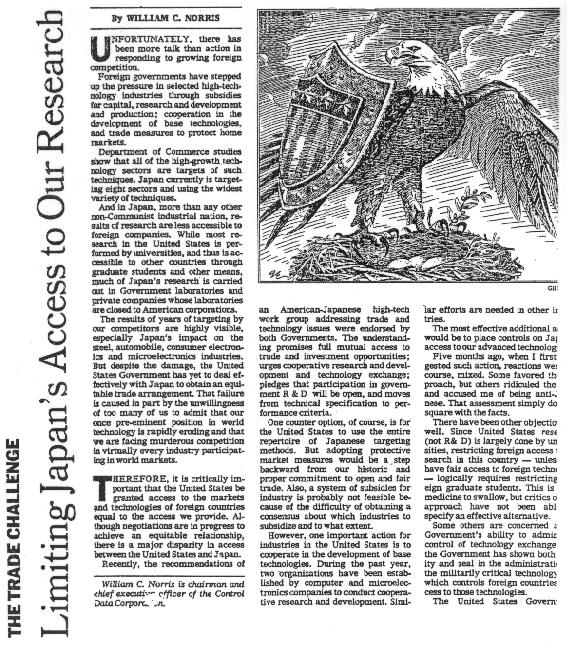

In spite of the FCC's decision, KDD took several months to adjust with their VENUS operation to inaugurate their International Computer Access Service (ICAS) (Asahi Shimbun, July 16, 1980) in September of 1980 (Nikkei Shimbun, July 31, 1980), until they learned that Bundespost (Germany's monopolistic telecommunication company) airshipped a router from the U.S. ICAS was an instantaneous success drawing many crowds to its demo (Nikkei Shimbun, September 5, 1980) with ten times more than expected users (Nikkei Shimbun, September 12, 1980) (Nikkei Shimbun, December 22, 1980).

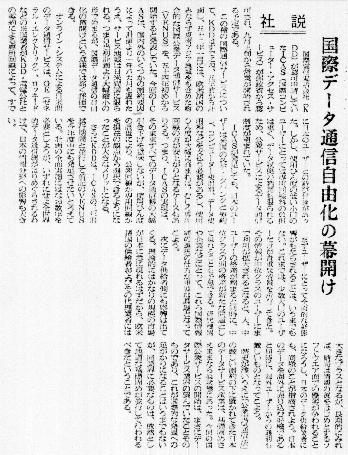
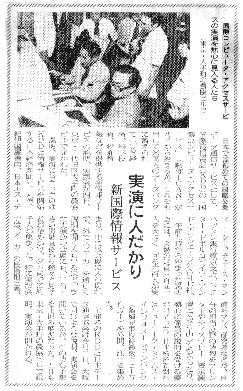
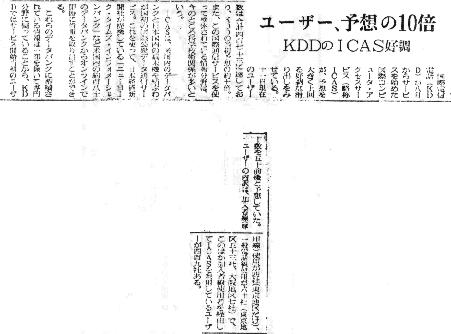

3.4 Prohibition of the use of e-mail
However, when I read the user manual of ICAS, I found a fine print saying that the exchange of a message by a computer without changing its contents (e.g., e-mail, etc.) was prohibited. KDD was also cunning enough to have deliberately used the word "processing" instead of "changing" in its English version for overseas users, as if it would have complied with ITU's CCITT recommendations.
According to this regulation, a Japanese user had to use bulky and expensive telex to send his request for a full paper after searching a desired paper by abstracts in a databank, to the information service providers in the U.S. KDD affirmed this when I inquired about it. This was obviously against my original intention of extending the U.S. data telecommunications network to Japan, for using e-mail for collaborative communications among peace gaming players and for questions and answers (Q&A) between instructors and students and among students of my planned Global University System [46].
3.5 De-regulation of the Japanese telecommunications policy for the use of e-mail through the U.S. government
After investigating the situations with the Japanese Ministry of Post and Telecommunications, Diet members, NTT, KDD, and information service providers in Japan in the spring of 1981, I reported it at a meeting at the U.S. Commerce Department, which gathered staffs from the White House, State Department, USTR, USTFC, FCC, NTIA, USIA, etc. I urged them to pressure the Japanese government for the de-regulations of their telecommunications policies, particularly for the use of e-mail and computer conferencing system. I also warned them that severe U.S.-Japan trade conflicts would rise soon after the divesture of AT&T. In order to secure my appeal to them, I submitted a thick petition with many letters of support to the Commerce Department in August of 1981.
When Late Commerce Secretary Malcom Baldrige visited Japan in October of 1981, he requested the de-regulation of the Japanese telecommunications policy for the use of e-mail and computer conferencing through U.S.-Japan public packet-switching lines, as one of three non tariff barriers (Chunichi Shimbun, October 31, 1981) -- this was the first of many subsequent U.S.-Japan trade issues on the non-tariff barriers. The Japanese Ministry of Posts and Telecommunications and KDD finally complied with my request and started allowing the use of e-mail from April 1, 1982 (U.S. Dept. of Commerce, 1982, Letter of Notification) [47].

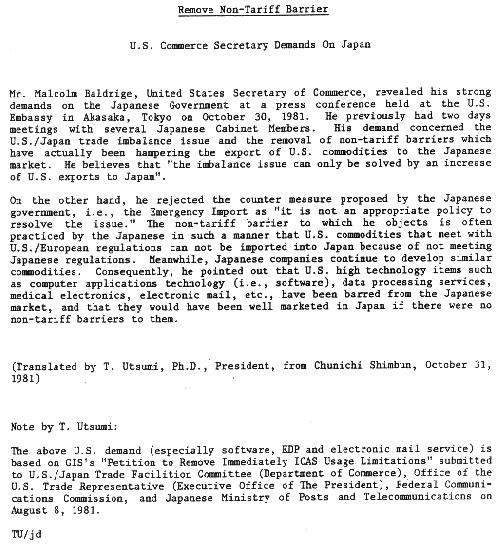
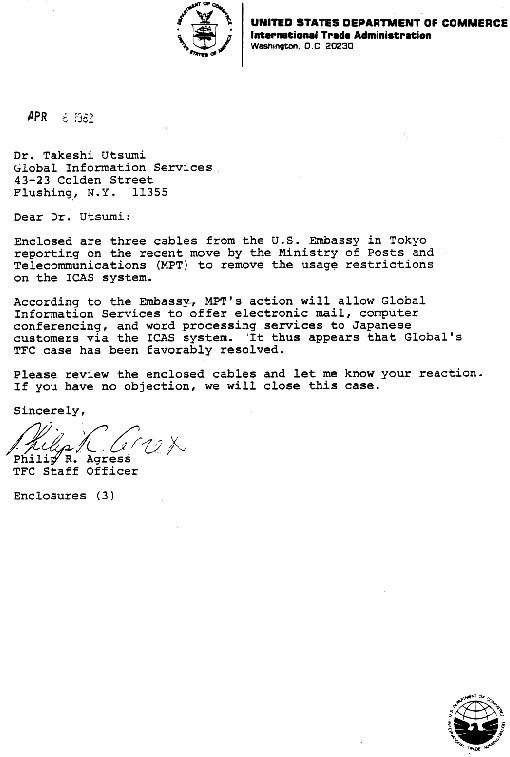
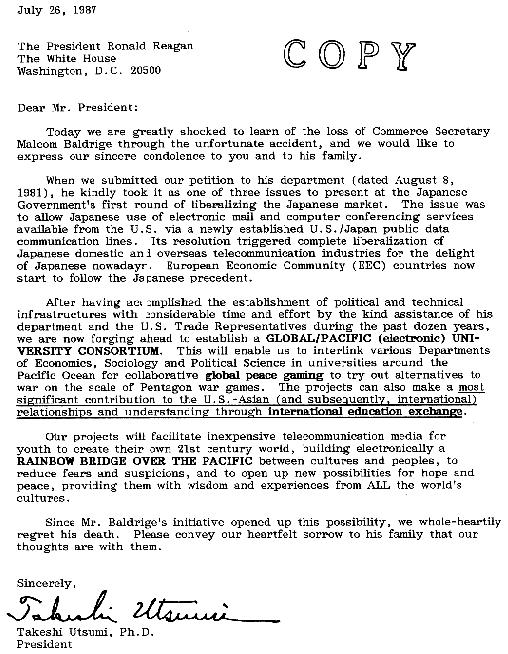
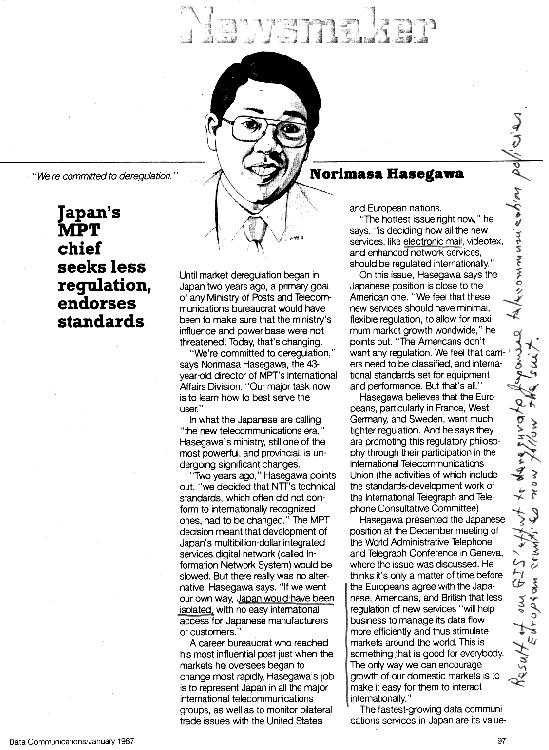 Around this time, KDD inaugurated their VENUS data telecommunications service. I requested a U.S. Commerce Department officer to obtain its user manual for me, since I could not trust their operation from my previous experiences. I found the prohibition of e-mail with VENUS in the user manual, even though its use was approved via ICAS by the economic ministers' committee. I had then again to spend several more months for its de-regulation through another agency of the Japanese government. Even after this de-regulation, it was only for Japanese using American e-mail services but not the other way around.
Around this time, KDD inaugurated their VENUS data telecommunications service. I requested a U.S. Commerce Department officer to obtain its user manual for me, since I could not trust their operation from my previous experiences. I found the prohibition of e-mail with VENUS in the user manual, even though its use was approved via ICAS by the economic ministers' committee. I had then again to spend several more months for its de-regulation through another agency of the Japanese government. Even after this de-regulation, it was only for Japanese using American e-mail services but not the other way around.
In April of 1984, the Japanese Ministry of Posts and Telecommunications made a major revamping of telecommunications policies. I sent again many thick petitions to the U.S. and the Japanese governmental agencies, AT&T, IBM, Hughes Aircraft, Honeywell, Telenet/Tymnet, CSC, CDC, Lockheed, SDC and many other major industries, and President Reagan, Commerce Secretary Baldrige, etc. I urged the U.S. Trade Representatives (USTR) to pressure the Japanese government [48]. Almost all of my requests on the complete liberalization of data telecommunications and penetration of American service companies to Japan [49] were conveyed by the USTR and American Ambassador to the Japanese government and finally approved.
The above efforts helped achieve a de-monopolization and liberalization of the Japanese telecommunication industries, thus enabling various private terrestrial and satellite communication service companies to emerge. This easing of restrictions included a statutory provision allowing the entry of foreign enterprises (particularly IBM's network) into the Japanese telecommunication markets. This enabled cost reductions of telecommunications -- down to one fifth to one eighth of the previous cost in only one decade. The European Economic Community (EEC), Latin American countries and others have followed the suit (now 80 countries with Internet access and 180 with e-mail access). Japanese initiatives were a model for the world (Berger, Michael, 1987, "Newsmaker: Japan's MPT chief seeks less regulation, endorses standards," Data Communication, January, Page 97 to 98) [50]. The way has been paved for the global educational exchange with experiential learning via various telecommunication media in the service of better understanding of global issues.
3.6 Extension of NSF's CSNET to Japan
 Computer Science Research Network (CSNET) of the U.S. National Science Foundation (a predecessor to Internet) was a general purpose communication network capable of linking all computer science research groups in universities, industry and government in the United States. CSNET was a logical network spanning several physical computer communication networks, including ARPANET, public packet networks (e.g., TELENET and TYMNET), and PHONENET (a telephone based message relay system). PHONENET used telephone links to incorporate hosts not residing on any network into CSNET. As new public networks were established, CSNET expanded to accommodate hosts connected to them.
Computer Science Research Network (CSNET) of the U.S. National Science Foundation (a predecessor to Internet) was a general purpose communication network capable of linking all computer science research groups in universities, industry and government in the United States. CSNET was a logical network spanning several physical computer communication networks, including ARPANET, public packet networks (e.g., TELENET and TYMNET), and PHONENET (a telephone based message relay system). PHONENET used telephone links to incorporate hosts not residing on any network into CSNET. As new public networks were established, CSNET expanded to accommodate hosts connected to them.
Gateways connected the component networks (Diagram of CSNET). Adoption of a common addressing method and a uniform protocol architecture enabled communication between any two CSNET hosts. As the project developed, interprocess communication protocols and additional capabilities were added. CSNET evolved by adopting new technologies as it became available; it continued to offer state-of-the-art computer communications services to the computer science research community.
CSNET used existing facilities where they were available. Some sites had ARPANET connections. Other sites gained access through public packet network connections. Sites that could not justify connection into a public packet network gained access to CSNET via PHONENET. Individual researchers who could not gain access by any of these methods could still use CSNET via a so-called Public Host. Every computer science researcher therefore had some access route to this complex.
Communication services provided initially included message services, file transfer, and access to remote database and system resources. Message service permitted rapid exchange of messages or documents from one researcher to another. The impediments to communication posed by differing work schedules, time zones, delivery delays, and the higher cost of long distance telephone were thereby avoided. File transfer permitted software packages or data to be shipped along with the network from one computer to another. For instance, design files for fabrication of integrated circuits could be transported in this way. Remote database access involved the reading and writing of data in files of other researchers at remote locations. Thus, a variety of databases could be maintained over the network such as software directories and technical papers. The availability of these services amplified the effectiveness of communication among computer scientists.
In 1981, I made an initial effort of extending this CSNET to Japan as contacting echelons of Japanese government and Liberal Democratic Party (Extension of CSNET to Japan). This project was later undertaken by Professor Haruhisa Ishida of the University of Tokyo (Ishida, H., 1991). Professor Ishida is now the Chairman of the Internet Association of Japan.
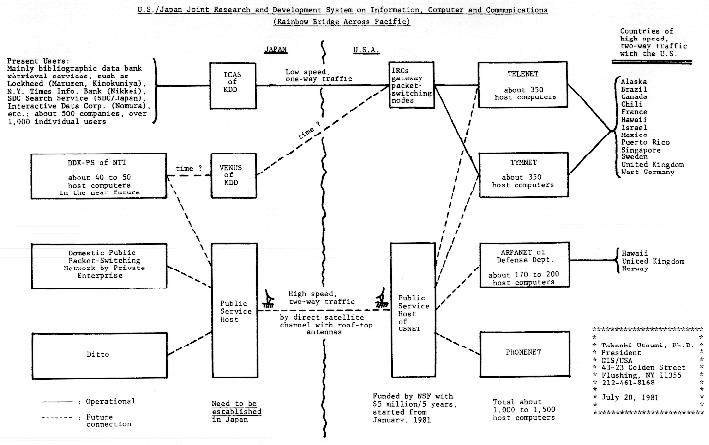
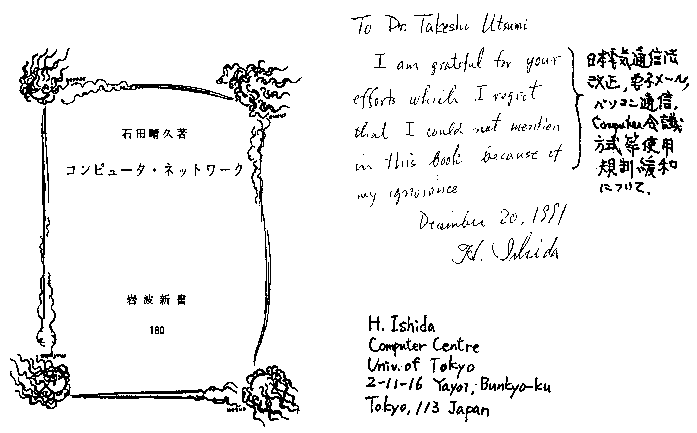
The most satisfying and delightful words I received during my visit to Japan in April of 1998 was an acknowledgement given from Dr. Hiroshi Inose, Director General of the National Center for Science Information System (NACSIS) of the Japanese Ministry of Education, who said to me; "Thank you, Dr. Utsumi, for your effort which brought Internet into Japan." The NACSIS is the center of the inter-university Internet in Japan which administers the broadband backbone network and a gateway to overseas countries. Dr. Inose is the Laureate of the Medal of Culture (the "Bunka Kunsho" in Japanese), the highest honor in Japan.
 On the other hand, however, I was very dismayed to find out that the use of Internet in Japan was greatly behind to the U.S. -- more than 10 years, according to Professor Shumpei Kumon, Director of Global Communication Center of the International University in Tokyo (FORBES, June, 1998, Japanese version). This is in comparison to the enthusiastic support of the U.S. Congress and the White House administration to proliferate the Internet to every elementary and secondary schools in the U.S. This Japanese lag may be due to (a) scarce competition among Internet service providers, (b) tradition and culture of education system, (c) feudalistic, vertical hierarchy of society, (d) political governance of K-12 education separating from higher education system, etc.
On the other hand, however, I was very dismayed to find out that the use of Internet in Japan was greatly behind to the U.S. -- more than 10 years, according to Professor Shumpei Kumon, Director of Global Communication Center of the International University in Tokyo (FORBES, June, 1998, Japanese version). This is in comparison to the enthusiastic support of the U.S. Congress and the White House administration to proliferate the Internet to every elementary and secondary schools in the U.S. This Japanese lag may be due to (a) scarce competition among Internet service providers, (b) tradition and culture of education system, (c) feudalistic, vertical hierarchy of society, (d) political governance of K-12 education separating from higher education system, etc.
See more for the reason why Japan cannot transform its society from the manufacturing age to nformation/knowledge age in Kunii, I. M. and B. Bremner, "Will Technology Leave Japan Behind?", BUSINESS WEEK, August 31, 1998, Pages 124 and 126. After reading this article, refer also to Section 1 and Section 2 of Chapter 2 for more deeper, cultural and religious reasons why Japan cannot transform their society. On the other hand, Japan is said to be the second economic power after the U.S., and their banking and financial systems with the Japanese Ministry of Finance are the most trusted establishments in Japan. However, it recently revealed that they have more than $1,000,000,000,000 dollar bad debt after series of scandals, and they are now in the worst depression since the World War II which is now threatening to trigger the global recession. Because of these double troubles (both of which are based on the cultural and religious fundamentals in Japan), I am afraid that such a serious global economic recession may be inevitable to come in the near future.Only way to avoid such a catastrophe would be to force Japan accelerate their social transformation with the proliferated use of Internet for tele-education and tele-medicine. This is one of my major motivations of devoting my life in those fields in global scale -- refer to Rector Hironaka's remark of me in Section 3.12 below.
3.7 Electronic Information Exchange System (EIES)
At the International Conference on Computer Communications (ICCC) held in Washington, D.C. in October, 1972 (which was mentioned above), I saw a demonstration of EMISARI computer conferencing system. This was used at the Executive Office of the President for Wage and Price Control program under Nixon administration. I thought this would be the most suitable coordination media among peace gaming players.
The successor of EMISARI was the Electronic Information Exchange System (EIES) of the New Jersey Institute of Technology [51]. After the de-regulation of e-mail in Japan, I started marketing it to many secondary schools in Japan. However, it was a difficult task because Japanese were usually shy to express themselves in addition to their language problem with English.
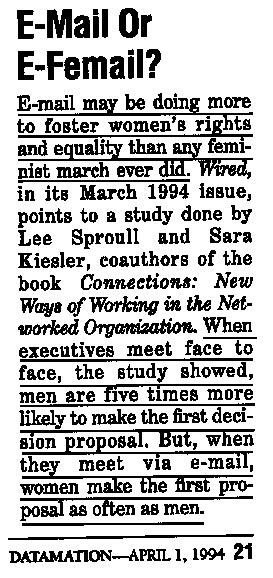 Although this was only text-oriented message exchange system, it was used for several pioneering distance education programs with students from around the world. One of the interesting results was that, if distance education was used, oriental students often submitted twice much materials than American students, though orientals were usually shy and not to raise questions at the face-to-face classrooms. Same is said about female (Datamation, April 1, 1994, "E-Mail Or E-Female?").
Although this was only text-oriented message exchange system, it was used for several pioneering distance education programs with students from around the world. One of the interesting results was that, if distance education was used, oriental students often submitted twice much materials than American students, though orientals were usually shy and not to raise questions at the face-to-face classrooms. Same is said about female (Datamation, April 1, 1994, "E-Mail Or E-Female?").
Equivalently excellent computer conferencing system around that time was NOTEPAD made by Jack Vallee, which was used by many industrial firms, non-profit organizations, and even by NASA. When it was proliferated among NASA employees, its echelons were bewildered with many messages they received everyday so that they had to stop the use of e-mail. Right after this, Challenger disaster occurred, since the message warning the deficiency of O-ring in cold weather from an engineer of Thiokol could not reach to the top of NASA just a few days prior to the disaster [52]. The engineer was happened to be my junior graduate from the Chemical Engineering Department of Montana State University in Bozeman, Montana -- he received a medal from the university later.
3.8 Distance learning with EIES
In January of 1985, I had an opportunity to receive a scholarship to take the first distance learning seminar with the use of EIES for six months, which was organized by Western Behavioral Science Institute in La Jolla, California. The lecturers were prominent scholars, such as Walter Roberts, founder of the National Center for Atmospheric Research (NCAR) in Boulder, Colorado, and the former president of American Association for the Advancement of Science, etc. Students were from industries and governmental agencies. Prior to the distance learning seminar, they conducted a face-to-face workshop and conference where lecturers presented the outlines of their planned courses and students could learn how to log on the EIES with their personal computer and a modem at their office or home. Albeit only text-oriented messages, discussions through EIES were very intensive and interesting -- for two months for each lecturer. However, our discussions were sparse during the session of the lecturer who missed the face-to-face meeting in La Jolla.
This experience taught me how important and effective the face-to-face meeting prior to the distance learning seminar is. In other words, if we can have a good human contact with a face to-face meeting, we need not always have video of instructors during distance learning -- more later.
3.9 Marketing of U.S. software
The USTR also pressured Nippon Telegraph and Telecommunications (NTT) for their liberalization of procurement policy to buy American equipment and computer software. Dr. Saburo Okita (former chief of Japan Club of Rome) visited Washington, D.C. to sign the agreement. I then helped marketing a software engineering system to the central laboratory of NTT which was equivalent to Bell Lab of AT&T in New Jersey. This system was based on a mathematical model of Rayleigh equation (which has a skewed probability curve), and to be used for planning of a software development project for cost saving and improving its programming quality. This was one of the three items NTT firstly purchased from overseas countries [53]. For its customer service, we extensively used EIES.
3.10 Marketing of HEP
In early 1970s, there was an international conference on computer simulation in Tokyo. I met David Miller of Denelcor (mentioned above) there and discussed the possibility of massively parallel digital processor as replacing amplifiers of analog computer with digital processors. He later developed Heterogeneous Element Processor (HEP) with Max Gilliland, who developed the hybrid computer at Beckman Instrument (mentioned above), for the U.S. Army Ballistic Research Laboratories. This was the first commercially available parallel digital computer with 50 digital processors with "Multiple Instruction Multiple Data (MIMD)" stream structure to achieve 500 million instructions per second [54]. I helped him to market it in Japan, but in vain -- due to the difficulty of its programming, compared with some successful installations in the U.K., Germany and other European countries [55].
3.11 De-regulation for the use of receive-only antenna
In 1990, I also made an effort to de-regulate the Japanese telecommunication policies for the use of receive-only antenna to receive signals directly from INTELSAT satellites for educational and non-profit purposes.
Extending communications through a global network and sharing ideas and educational opportunities with other locations is of a paramount interest. The quality of education for those unable to attend conventional universities in disadvantaged countries could be greatly enhanced. Such distance educational service can also become an exportable commodity to remedy American trade deficits.
The INTELSAT system was originally established for satellite telecommunications. Because of its monopolistic structure, downlinking (including micro-waving from its signatories' earth stations to user sites) cost an amount that was prohibitive for any educational use, in contrast to the fact that uplinking from the U.S. was de-monopolized and became inexpensive. On the other hand, due to the advent of the Very Small Aperture Terminal (VSAT) antenna, signals from INTELSAT had been eavesdropped (unofficially) at various sites (in a similar way as a home TV set) for testing and educational purposes in Japan. It was technically possible to utilize INTELSAT satellites inexpensively for one-way broadcasting of educational courses from the U.S., if the monopolistic regulation was cleared. Once the Japanese policy was de-regulated on this matter, other countries might have followed the suit, as was the case for the use of e-mail and computer conferencing, etc., in Europe, East Asia, Australia, and Latin America, as mentioned above.
This affordable trans-Pacific educational services would be the basis of our planned Global/Pacific (electronic) University (GPU) when other Pacific periphery countries followed the Japanese lead, since the foot-print of the INTELSAT satellite could well cover some of those areas, too. Private international satellites, such as PAN-AM, ASIASAT, etc., would also provide us with a glut of international satellite capacity to make the cost even cheaper -- more suitable for the educational use.
Thanks to the letters of support from more than 50 universities and organizations I received, the Japanese Ministry for Posts and Telecommunications de-regulated this issue in 1994.
3.12 Remarks
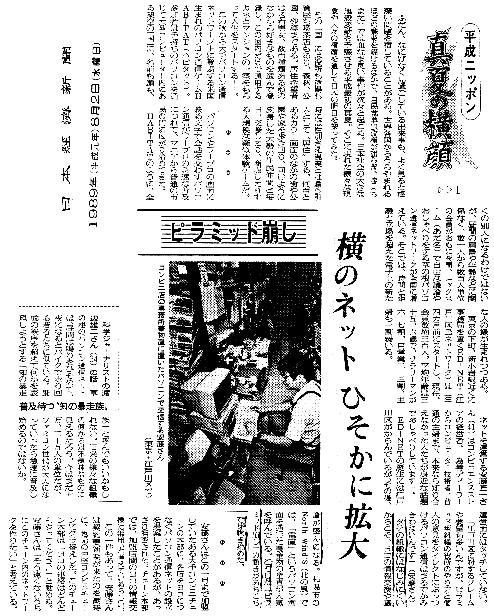 I have achieved so far a part of my life task with my considerable time, efforts and private funds in the past two decades -- it was certainly a long, lonely strenuous road [56], since dealing with Japanese, particularly its government and monopolistic telecommunication industries (e.g., KDD) was like peeling the onion, as many American trade negotiators criticized!! I was, however, fortunate to have the generous support and help from the U.S. White House, the U.S. Trade Representative (USTR), the U.S. Department of Commerce (particularly the Late Secretary Malcom Baldrige), the U.S. Federal Communications Commission, American educational and industrial organizations, and the Japanese Liberal Democratic Party (especially, Mr. Tadashi Kuranari, former Minister of Foreign Affairs and one of my family friends), to name but a few among many in the U.S., Japan and other countries.
I have achieved so far a part of my life task with my considerable time, efforts and private funds in the past two decades -- it was certainly a long, lonely strenuous road [56], since dealing with Japanese, particularly its government and monopolistic telecommunication industries (e.g., KDD) was like peeling the onion, as many American trade negotiators criticized!! I was, however, fortunate to have the generous support and help from the U.S. White House, the U.S. Trade Representative (USTR), the U.S. Department of Commerce (particularly the Late Secretary Malcom Baldrige), the U.S. Federal Communications Commission, American educational and industrial organizations, and the Japanese Liberal Democratic Party (especially, Mr. Tadashi Kuranari, former Minister of Foreign Affairs and one of my family friends), to name but a few among many in the U.S., Japan and other countries.
As the result, the use of e-mail (the so-called PASOCON-TSUSHIN (= personal computer telecommunication) in Japanese) became proliferated in Japan as reforming a hierarchical structure of the Japanese society to horizontal, achieving a goal of my effort (Nikkei Shimbun, August 2, 1989 [57]). I was particularly happy when I saw an article in Nikkei Shimbun a few years ago which the results of a survey reported that almost 50% of Japanese youngsters now do no longer want to have life-long employment system -- see also my acceptance speech of the Lord Perry Award for Excellence in Distance Education.
A Japanese newspaper described that the inauguration of international data telecommunication services (ICAS and VENUS of KDD) was the "Third Opening of Japan," following the second of introducing democracy by General Douglas MacArthur and the first by Commodore Perry's black ship about 150 years ago.
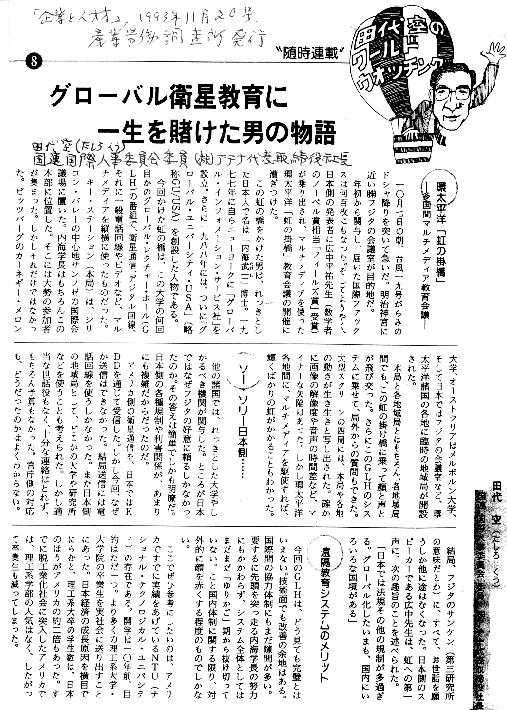 In view of my effort of introducing the U.S. packet-switching data telecommunication network to Japan, de-regulation and de-monopolization of the Japanese telecommunication policies and industries, and their consequential impact to the Japanese society, Rector Hironaka of Hiroshima University (former dean of mathematics at Harvard University and Field Award laureate) termed me as a revolutionist as Ryuma Sakamoto, who initiated Meiji revolution about 130 years ago (Tashiro, Ku, 1993) [58].
In view of my effort of introducing the U.S. packet-switching data telecommunication network to Japan, de-regulation and de-monopolization of the Japanese telecommunication policies and industries, and their consequential impact to the Japanese society, Rector Hironaka of Hiroshima University (former dean of mathematics at Harvard University and Field Award laureate) termed me as a revolutionist as Ryuma Sakamoto, who initiated Meiji revolution about 130 years ago (Tashiro, Ku, 1993) [58].
I was also very happy to learn that 80 million people now use e-mail worldwide (40 million in the U.S.) and 60% of Internet usage for e-mailing. A colleague in Croatia said "GLOSAS project is the Archimedes' lever" [59].
"The GLOSAS Project is Dr. Utsumi's second social revolution!" said a high ranking officer of the Japanese Ministry of International Trade and Industry (MITI) in the summer of 1991, referring to the fact that the deregulation significantly contributed to and continued to exert influences on the change in the Japanese society and industry.
Information and telecommunication are the very basic infrastructure of economic development, as attested by the rapid rise of Japan to the world economic power after the de monopolization and liberalization of the telecommunication policies and industries in early 1980s. This also brought a transformation and upheaval of the Japanese society from being feudalistic (vertical) to democratic (horizontal). Yet, that was after her reformation of only hardware-oriented information infrastructure. Our projects now focus more on substance and content of the information, i.e., knowledge and education. This was the reason why the above comment was made by the MITI officer.
REFERENCES:
Utsumi, T., C. H. Jones and L. Chin, 1970, "Optimization of CSMP/360 or Hybrid Models," 1970 SCSC Proceedings, Pages 143-153.
Utsumi, T. and A. Garzon, 1991, "Global University for Global Peace Gaming," Proceedings of the 22nd International Conference of the International Simulation and Gaming Association (ISAGA), Kyoto, Japan, 15-19 July, 1991, Pages 112 to 120, Springer-Verlag
Utsumi, T. and E. A. Eschbach, 1974, "Joint USA/Japan Project on Global Systems Analysis and Simulation (GLOSAS) of Energy, Resources and Environmental (ERE) Systems," Proceedings of 1974 SCSC, Houston, TX, July, 1974, Pages 343-353.
[Go to CONTENTS]
INSERTIONS (Images, graphs and diagrams, etc.):
Asahi Shimbun, March 12, 1979, "Real-time Databank Retrieval from the U.S.," In Japanese (Permission to be obtained later.)
Asahi Shimbun, July 16, 1980, "Inauguration of KDD's ICAS Service:
Instantaneous Information Retrieval from the U.S.," In Japanese (Permission to be obtained later.)
Berger, Michael, 1987, "Newsmaker: Japan's MPT chief seeks less regulation, endorses standards," Data Communication, January, Page 97 to 98 (Permission to be obtained later.)
BUSINESS WEEK, August 31, 1998, Pages 124 and 126, "Will Technology Leave Japan Behind?", by Kunii, I. M. and B. Bremner
Chunichi Shimbun, October 31, 1981, "Remove Non-Tariff Barrier," In Japanese and English translation (Permission to be obtained later.)
Computing Europe, February 16, 1978, Reports on a Transnational Data Regulation Conference (Permission to be obtained later.)
Datamation, April 1, 1994, "E-Mail Or E-Female?" Page 21 (Permission to be obtained later.)
Ishida, H., 1991, Private communication
Malik, R., September 8, 1977, "In person: Packet-switching's unsung hero," New Scientist (Permission to be obtained later.)
Millennium Institute, "Cause and Effect Diagram of Threshold 21 National Sustainable Development Model," <http://www.igc.org/millennium/t21/index.html#intro> (Permission granted on July 23, 1998, by an e-mail.)
National Science Foundation, "Diagram of CSNET," 1981
Nikkei Sangyo Shimbun, March 22, 1979, "Networking Industry: Mountain of Treasures," In Japanese (Permission to be obtained later.)
Nikkei Shimbun, November 4, 1973, "Japan-U.S. Online Energy Information via Satellite," In Japanese (Permission to be obtained later.)
Nikkei Shimbun, November 27, 1978, "Information Retrieval from the U.S.," In Japanese (Permission to be obtained later.)
Nikkei Shimbun, December 15, 1979, "FCC allowed KDD's ICAS," In Japanese (Permission to be obtained later.)
Nikkei Shimbun, July 31, 1980, "Opening of International Data Telecommunications Services," In Japanese (Permission to be obtained later.)
Nikkei Shimbun, September 5, 1980, "Demonstration of ICAS Services," In Japanese (Permission to be obtained later.)
Nikkei Shimbun, September 12, 1980, "Many ICAS Users: More than Ten Times than Expected," In Japanese (Permission to be obtained later.)
Nikkei Shimbun, December 22, 1980,"Prosperous Online Services," In Japanese (Permission to be obtained later.)
Nikkei Shimbun, August 2, 1989, "Crumbling Down Pyramid," In Japanese (Permission to be obtained later.)
Norris, William C., 1983, "Limiting Japan's Access to Our Research," The New York Times, July 24, (Permission to be obtained later.)
Tashiro, Ku, 1993, "Story of the Man who Devoted His Life to Global Distance Education," Kigyo to Jinzai, November 20, 1993, In Japanese (Permission to be obtained later.)
U.S. Dept. of Commerce, 1982, Letter of Notification, April 6.
Utsumi, T., 1970, "A Message from the Program Chairman," Proceedings of the 1970 SCSC, Denver, Colorado
Utsumi, T., 1971a, "A Message from the General Chairman," Proceedings of the 1971 SCSC, Boston, Massachusetts
Utsumi, T., 1971b, "Peace and War Gaming"
Utsumi, T., 1971c, "Comparison between War and Peace Games"
Utsumi, T., 1981, "Extension of CSNET to Japan"
[ Top of this page | GLOSAS home page | List of Activities ]